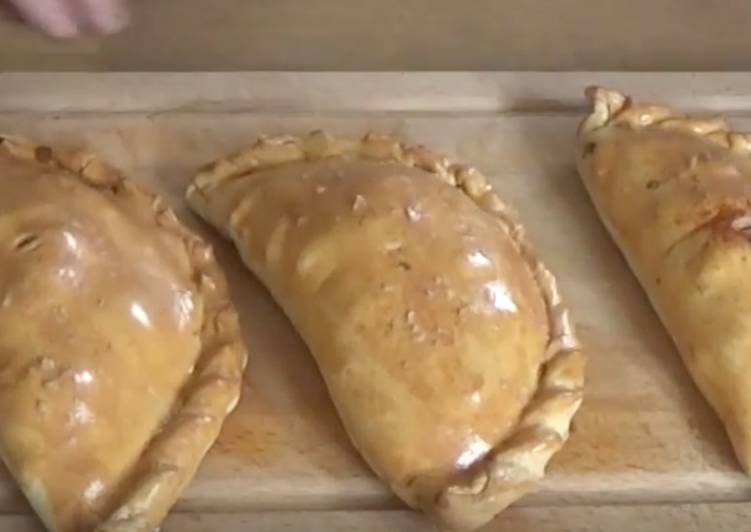Traditional Cornish Pasties. Cornish Pasties with tender peppery chunks of beef mixed with melt-in-your-mouth vegetables, all Cornish Pasties - moist and tender traditional hand pies filled with steak, onion, potato and swede. A traditional Cornish pasty is one of the first ever fast foods, steeped in history, heritage, and Pasties may no longer be the food of tin miners, but they are one of the nation's favorite snack or. A shortcrust pastry is a perfect pastry for a traditional Cornish Pasty.
 Traditional Cornish pasty recipe, delicious British beef pasties with rutabaga and potatoes.
The Cornish pasties have a long history.
They originate in Cornwall - Great Britain and the story says.
You can have Traditional Cornish Pasties using 14 ingredients and 11 steps. Here is how you cook that.
Traditional Cornish pasty recipe, delicious British beef pasties with rutabaga and potatoes.
The Cornish pasties have a long history.
They originate in Cornwall - Great Britain and the story says.
You can have Traditional Cornish Pasties using 14 ingredients and 11 steps. Here is how you cook that.
Ingredients of Traditional Cornish Pasties
- Prepare of for the pastry.
- You need 500 g of x strong flour.
- Prepare 120 g of beef suet.
- It's 50 g of x lard.
- Prepare 200 ml of x cold water.
- Prepare 1 tsp of x table salt and black pepper.
- Prepare of for the filling.
- Prepare 350 g of x skirt of beef.
- You need 350 g of x maris piper potatoes.
- It's 200 g of x swede.
- Prepare 175 g of x white onion.
- It's 1 tbsp of x chopped parsley and thyme.
- It's to taste of salt and pepper.
- You need 1 of x beaten egg for glaze.
The humble pasty is the signature dish of the Cornish and was basically a convenience food that could be kept warm wrapped. Traditional Cornish Pasty, savory packages of beef and potatoes wrapped in flaky, buttery pastry. This British classic makes a wonderful lunch or dinner on a chilly day. When you've crimped along the edge, fold Put the pasties onto the baking tray and brush the top of each pasty with the egg and salt mixture.
Traditional Cornish Pasties instructions
- Combine the lard, suet and water into the strong flour, along with the salt and pepper.
- Work with your hands for a few minutes, turn out onto a work surface when it looks shaggy, and continue to knead (like bread dough for 5 minutes) until you have a firm springy dough, wrap in cling film and refrigerate while you prepare the filling, if the dough will not form keep working with damp hands it will get there..
- Dice all of the vegetables to around 1cm, chop the herbs and mix in a bowl..
- Now dice the skirt, it has a very obvious grain, first cut into large batons with the grain about 1 1/2 inch thickness. Turn 90 degrees and slice 1/2 cm approx against the grain.
- Season well and thoroughly mix.
- Cut chilled dough into 4, keep the dough covered with cling film while not in use, form 1 piece into a ball and then flatten with your hand to form a round disc..
- Roll the pastry to the size of a large dinner plate, 10 - 12 inches, you do not need flour for this. Arrange 1/4 of the filling just below the centre..
- Place a small slice of butter on top of the filling (opt) I have a fetish for butter and think its makes everything better, it will create a little extra steam inside while baking. Lift the far side over the filling and form a semi circle.
- Firmly press the edges together (no water or egg required) and then crimp, have fun with this and don't obsess about perfection. Use 1 finger on 1 hand to hold the dough down and 1 finger of the other hand to fold and press the pastry over. Tuck the edges under.
- Firmly press the pasty into shape, pierce a small hole to allow steam to vent and arrange all four on baking sheets lined with baking parchment. Brush well with beaten egg, sprinkle with sea salt or seeds before baking.
- Bake at 170c for 1 hour 15 mins, you can't eat them until they've cooled down, they are best eaten warm or room temp with loads of ketchup, the last image is of me looking very pleased with my pasties. These screen shots are taken from my YouTube channel here is a link https://www.youtube.com/watch?v=1EAx_iugdFc&t=231s.
As promised, here is the recipe for the Cornish Pasties that were featured earlier this week. Next comes the hardest part: getting the twisted edges. These are a vital part of a traditional pasty. The traditional recipe for the pasty filling is beef with potato, onion and swede, which Superstition and Tradition. The pasty is such a celebrated emblem for Cornwall that when the Cornish rugby.